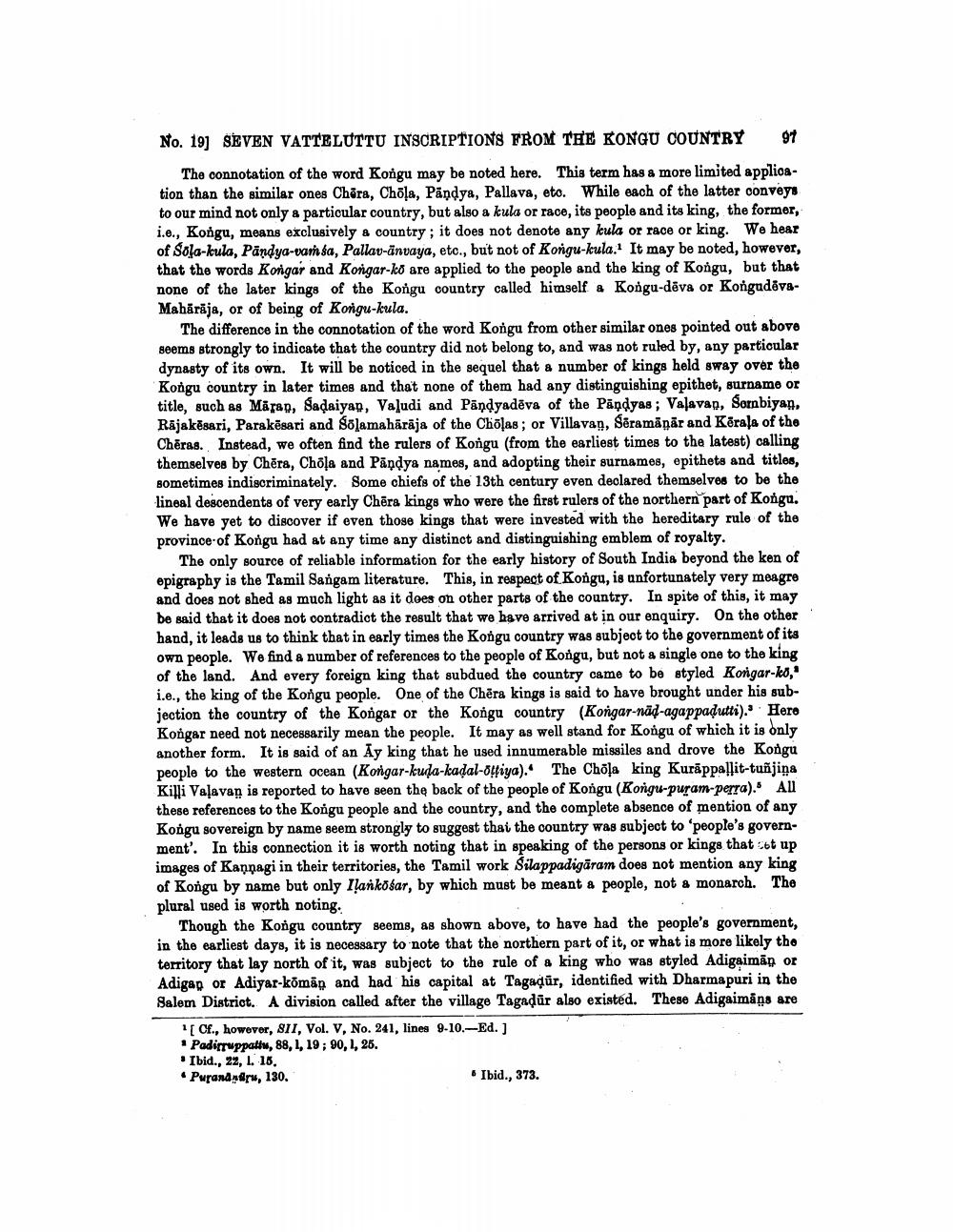________________
No. 19) SEVEN VATTELUTTU INSCRIPTIONS FROM THE KONGU COUNTRY
97
The connotation of the word Kongu may be noted here. This term has a more limited application than the similar ones Chira, Chola, Pandya, Pallava, eto. While each of the latter conveys to our mind not only a particular country, but also a kula or race, its people and its king, the former, i.e., Kongu, means exclusively & country; it does not denote any keula or race or king. We hear of Sola-kula, Pandya-vam sa, Pallav-invaya, etc., but not of Kongu-kula. It may be noted, however, that the words Korgar and Kongar-ko are applied to the people and the king of Kongu, but that none of the later kings of the Kongu country called himself a Kongu-dēva or KongudēvsMahārāja, or of being of Kongu-kula.
The difference in the connotation of the word Kongu from other similar ones pointed out above seems strongly to indicate that the country did not belong to, and was not ruled by, any particular dynasty of its own. It will be noticed in the sequel that a number of kings held sway over the Kongu country in later times and that none of them had any distinguishing epithet, surname or title, such as Mājan, Sadaiyan, Valudi and Pandyadēva of the Pāņdyas; Valavan, Sornbiyan, Rajakesari, Parakēsari and Solamahārāja of the Cholas; or Villavan, Sēramāņār and Kerala of the Chēras. Instead, we often find the rulers of Kongu (from the earliest times to the latest) calling themselves by Chēra, Choļa and Pandya names, and adopting their surnames, epithets and titles, sometimes indiscriminately. Some chiefs of the 13th century even declared themselves to be the lineal descendents of very early Chēra kings who were the first rulers of the northern part of Kongu. We have yet to discover if even those kings that were invested with the hereditary rule of the province of Kongu had at any time any distinct and distinguishing emblem of royalty.
The only source of reliable information for the early history of South India beyond the ken of epigraphy is the Tamil Sangam literature. This, in respect of Kongu, is unfortunately very meagre and does not shed as much light as it does on other parts of the country. In spite of this, it may be said that it does not contradict the result that we have arrived at in our enquiry. On the other hand, it leads us to think that in early times the Kongu country was subject to the government of its own people. We find a number of references to the people of Kongu, but not a single one to the king of the land. And every foreign king that subdued the country came to be styled Kongar-ko," i.e., the king of the Kongu people. One of the Chēra kings is said to have brought under his subjection the country of the Kongar or the Kongu country (Kongar-nād-agappadutti)." Hero Kongar need not necessarily mean the people. It may as well stand for Kongu of which it is only another form. It is said of an Ay king that he used innumerable missiles and drove the Kongu people to the western ocean (Kongar-kuda-kadal-oltiya). The Choļa king Kurāppaļļit-tuñjina Killi Valavan is reported to have seen the back of the people of Kongu (Kongu-puram-perra). All these references to the Kongu people and the country, and the complete absence of mention of any Kongu sovereign by name seem strongly to suggest that the country was subject to 'people's government. In this connection it is worth noting that in speaking of the persons or kings that cot up images of Kaņpagi in their territories, the Tamil work Silappadigāram does not mention any king of Kongu by name but only Ilankosar, by which must be meant & people, not a monarch. The plural used is worth noting.
Though the Kongu country seems, as shown above, to have had the people's government, in the earliest days, it is necessary to note that the northern part of it, or what is more likely tho territory that lay north of it, was subject to the rule of a king who was styled Adigạimān or Adigapor Adiyar-komāp and had his capital at Tagadür, identified with Dharmapuri in the Salem District. A division called after the village Tagadür also existed. These Adigaimans are
[ Of., however, 811, Vol. V, No. 241, lines 9-10.-Ed.] . Padiruppattu, 88, 1, 19; 90, 1, 25.
Ibid., 22, L. 15. • Purandad, 130.
* Ibid., 373.




